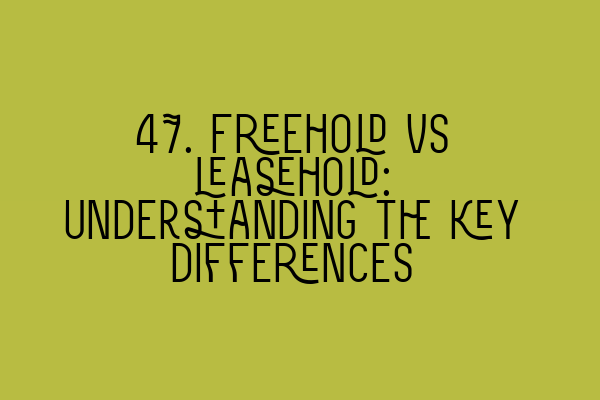Freehold and leasehold are two common forms of property ownership in the United Kingdom. Understanding the key differences between these two types of ownership is crucial, whether you are buying or selling a property, or simply seeking general knowledge about the property market. In this blog post, we will delve into the intricacies of freehold and leasehold, explaining their characteristics, advantages, and disadvantages. So, let’s get started!
Freehold, as the name suggests, refers to owning the land and the property outright. Simply put, when you buy a freehold property, you become the sole owner, with complete control and ownership rights. This means that you are responsible for all aspects of the property, including its maintenance, repairs, and insurance.
On the other hand, leasehold ownership involves owning a property for a fixed period of time, as specified in a lease agreement with the freeholder or landlord. With leasehold ownership, you have the right to occupy and use the property for the duration of the lease. However, you do not own the land on which the property stands.
Now that we have a basic understanding of freehold and leasehold, let’s dive deeper into the key differences between the two:
1. Ownership:
– Freehold: As mentioned earlier, with freehold ownership, you own the property and the land it stands on. You have complete control and can make decisions regarding the property without any restrictions from a landlord.
– Leasehold: With leasehold ownership, you only own the property for the duration specified in the lease agreement. The land ownership remains with the freeholder or landlord.
2. Duration:
– Freehold: Freehold ownership is indefinite and does not come with any time restrictions. Once you purchase a freehold property, you own it for an unlimited period.
– Leasehold: Leasehold ownership comes with a fixed term, typically ranging from 99 to 999 years, although some leases may be shorter. Once the lease period ends, ownership reverts back to the freeholder.
3. Responsibilities and Costs:
– Freehold: As a freeholder, you are responsible for all costs related to the property, including maintenance, repairs, and insurance. You have the freedom to make alterations or modifications to the property, subject to any necessary planning permissions.
– Leasehold: As a leaseholder, you are typically responsible for paying ground rent, service charges, and other fees to the freeholder. The lease agreement may also impose restrictions on alterations or modifications to the property.
4. Ground Rent and Service Charges:
– Freehold: Freeholders do not have to pay ground rent or service charges unless they live in a property managed by a management company or have a communal area that requires shared ownership and upkeep.
– Leasehold: Leaseholders are often required to pay ground rent to the freeholder, which is an annual fee for occupying the land. Additionally, leaseholders may also be responsible for service charges, which cover the maintenance and management of shared spaces in apartment buildings or estates.
5. Control and Decision-Making:
– Freehold: Freeholders have complete control over their property, allowing them to make decisions without seeking permission from others.
– Leasehold: Leaseholders often have limited control over their property and may need to obtain permission from the freeholder or management company for alterations, subletting, or even keeping pets.
It is important to note that leasehold properties often come with additional complexities, such as lease extensions, leasehold enfranchisement, and the right to manage. These aspects can significantly impact the value and marketability of leasehold properties, making it essential to seek legal advice when dealing with leasehold transactions.
In conclusion, the key differences between freehold and leasehold lie in the ownership rights, duration, responsibilities, costs, and decision-making abilities. Freehold ownership provides complete control and ownership of the property and land, while leasehold ownership comes with certain limitations and obligations. Understanding these distinctions is vital when navigating the property market and making informed decisions.
If you are preparing for the SQE exams and would like to enhance your knowledge in property law and land law, we recommend checking out our related articles:
– SQE 1 Practice Exam Questions
– SQE 1 Practice Mocks FLK1 FLK2
– SQE 2 Preparation Courses
– SQE 1 Preparation Courses
– SRA SQE Exam Dates
These resources will help you deepen your understanding of property law concepts and improve your chances of success in the SQE exams.
At SQE Property Law & Land Law, we are dedicated to providing high-quality legal education and support to aspiring solicitors. Whether you are preparing for the SQE exams or seeking expert advice on property matters, our team of experienced professionals is here to assist you.
If you have any further questions or would like to explore our services, please do not hesitate to reach out to us. We look forward to assisting you on your legal journey!
